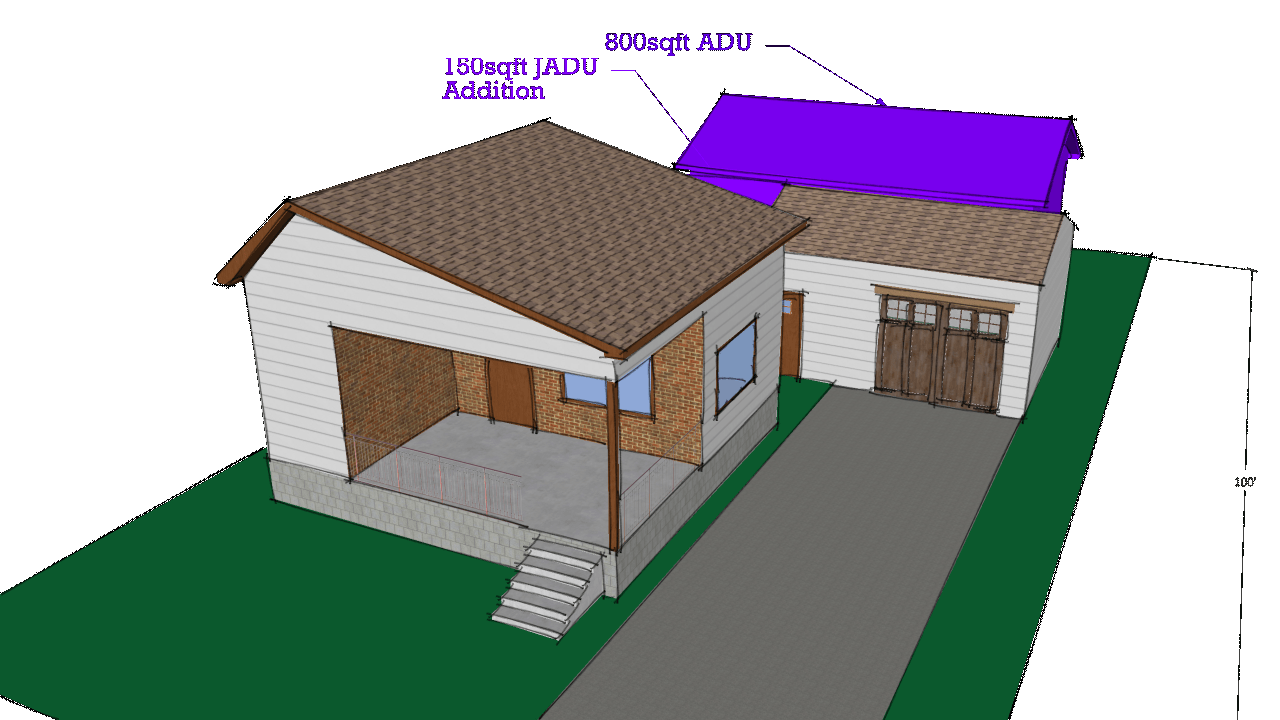Let’s Triplexize California
In October 2019, Governor Gavin Newsom signed three bills into law that effectively legalized no-hassle ADU construction across the entire state of California. Bills from later years added to this foundation, giving homeowners more options to build ADUs and junior ADUs.
If you own a single family home and wish you could do something to take on the state’s housing shortage in your own way, the time is now.

The new state laws break down most barriers to develop a new ADU and/or JADU on your property. You no longer need to worry about:
- Public hearings.
- Replacing parking when you convert your garage.
- Most local zoning requirements.
- Discretionary approval processes.
Build new or convert your garage, and consider adding a JADU too!
Cities have limited discretion when it comes to approving an ADU or JADU–almost none, in fact.
While state law does authorize a city to implement limitations on ADUs, state law prescribes another separate set of regulations that cities simply cannot overrule. Those regulations are:
- 4 foot setbacks
- Height limits of 16 feet for a detached ADU, 18 feet (plus two additional feet for roof pitch) for a detached ADU within half a mile walking distance of public transit, or 25 feet (or the height limit for the primary dwelling) for an attached ADU
- 850 square feet maximum, or 1000 square feet for a multi-bedroom ADU
For JADUs, cities can impose the following regulations:
- The unit must be contained within the existing space of a single-family residence
- 500 square feet maximum
- The owner of the primary residence must live in either the primary residence or the newly created JADU
That’s it. For years, cities hostile to the Californian dream of affordable housing everywhere have found ways to ban ADUs and JADUs.
New state law does away with all those barriers. Most Californian homeowners can now apply for an ADU, JADU, or both, over the planning counter. No hearings. No fighting the city. You don’t even need to ask your neighbor for their permission.
The California Housing Defense Fund has put together this easy guide to help homeowners get through the process and bring much needed housing to the state without contributing to sprawl.
Is your city putting up a fight?
The state’s housing crisis is 40 years in the making, in part because local cities consistently refuse to allow for more housing. New state laws aimed at making it easier for homeowners to build ADUs are no different and will be fought by Californian cities where housing is most needed, as they have for decades.
If your city is fighting your ADU application, it is very likely to be unlawful behavior. Submit a complaint to CaRLA and we will make sure that your city doesn’t get a free pass from state law.
We’re California’s housing watchdogs, but we depend on your eyes and ears to take action.
How does it work?
Building an ADU or JADU on your property requires financing, designing, and developing the project. The first step is to figure out how to pay for everything. Most ADUs or JADUs are financed using existing equity in the property, or the increased equity of the property based on the value of the ADU and/or JADU. Talk to your bank to figure out what options are available to you.
Next, you will need to figure out where on your property you can fit an ADU and/or JADU. Luckily, this year’s changes to statewide ADU law means that nearly every single-family property in California can fit an ADU and/or JADU. The law specifies two separate sets of rules governing where and how big of an ADU you can develop. The local ordinance provides one path, but you may find that local rules make it difficult to fit an ADU on your property. If this turns out to be the case, you can take advantage of the state rules, which all but guarantee each home one backyard detached ADU and a JADU converted from existing space. The allowable build envelope for an ADU can be substantially different from the requirements your local planning ordinance puts on single family homes. These drawings represent the average single family home lot which includes a 15′ front setback, 5′ side setbacks, a 30′ rear yard setback, includes a requirement for a covered parking garage. The state rules free up the back yard for a new detached ADU, subject only to a 4′ rear and side setbacks and a 16 foot height limit (18 feet, plus two additional feet for roof pitch, within half a mile walking distance of transit). Further, it allows you to convert space in the existing primary residence into a JADU, making your single-family property into a triplex!
Design and Build
Once you have figured out where to put your ADU and/or JADU, you’ll need to hire a contractor and architect who can design and build the new homes you’ll be creating. With the increasing popularity of ADUs, businesses are popping up all over the state to provide homeowners with these services. Go with someone with a good reputation who can get the job done, but also pays attention to all the new changes in state law so that you can take advantage of them.
In planning your ADU/JADU project you will have some choices to make. If you have an existing garage, you can probably convert it to a small ADU without having to build a whole new structure. This can keep costs down and simplify the construction process. If you are adding a new ADU in the backyard, you can choose to buy a pre-fabricated ADU from one of the many businesses around the state that install them. This process involves pouring a foundation and having the new home trucked in and lifted onto the foundation with a crane.
All of these choices can make a difference in the cost and type of ADU and/or JADU you want to develop. Remember that there are lots of options available once the new state law reforms go into effect. Find what suits you and your budget best and go for it!

We’re California’s Housing Watchdogs
Was this page helpful? Do you want more content like this from us?
CalHDF (formerly known as “CaRLA”) is supported through the donations of people like you. We’re a small 501c3 non-profit and need your help to hold cities accountable.
Consider making a tax deductible donation or joining us today with a monthly subscription.
Submit your application
Check with your local planning department to learn how to submit the application. If you’ve hired an architect or pre-fabricated ADU supplier, they’ll already know how to do this. This is also where cities will try and avoid their obligations under state law; CalHDF is ready to fight back.
Submitting your application should be quick and painless; if it isn’t, your city is probably breaking the law, and we need to know about it. Here are some things to watch out for:
Floor Area Ratio requirements: State law prohibits regulating the overall floor area of a single family property if it would prevent an 850 square foot ADU from being developed.
Distance between the ADU and the existing house: On small lots, these rules can make adding an ADU difficult. You may need to opt for the state approval process, which would bar the city from applying this requirement.
New or replacement parking for the ADU: Cities are prohibited from requiring additional parking for a new ADU in many circumstances, and cities can never require additional parking for a JADU. If you convert your garage to an ADU, cities are prohibited from requiring that you replace that parking. Use the savings on an annual bus pass or put it towards an e-bike!
Public hearings or discretionary design review: Nope. State law prohibits these too. While cities can ask that you follow a list of aesthetic design standards, they can’t put your approval to a vote, and those design standards must be objective. Words like “neighborhood character”, “harmonious context”, or even “appropriate massing” might indicate they’re breaking the law.
